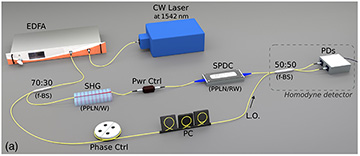
The experimental setup involves amplifying light from a telecom-wavelength laser, and then passing 70 percent of the light through a nonlinear array that implements squeezing. Comparison of the output signal with the other 30 percent of the light (acting as a local oscillator for a homodyne detector) allowed an assessment of the magnitude of squeezing. [Image: Kaiser et al., Optica, doi: 10.1364/OPTICA.3.000362] [Enlarge image]
A team of scientists in France and Italy, using off-the-shelf components from the fiber communications industry, has demonstrated the first fully guided-wave implementation of “squeezed light” at telecom wavelengths (Optica, doi: 10.1364/OPTICA.3.000362). By bringing the reduced quantum noise possible with squeezed-light approaches out of free space and into the all-fiber realm, the team believes, the finding could move continuous-variable quantum communication closer to compatibility with long-haul telecom networks. The setup also offers, in the researchers’ view, a platform for “do-it-yourself” experiments with squeezed light.
Ironing out quantum noise
The notion of squeezed light comes out of the discipline of quantum optics, and the thing being squeezed is the light field’s quantum noise. From the point of view of quantum optics, the noise of a light field in a coherent state is related to its quantum uncertainty; a measurement of the light field’s amplitude or phase can have different values in a circularly symmetric uncertainty region, with the uncertainty values dictated by Heisenberg’s classic relationship. One can achieve lower noise in amplitude or phase by using nonlinear-optics approaches to “squeeze” that circular uncertainty region into an ellipse—for example, by reducing uncertainty in the amplitude component while increasing uncertainty in the phase.
The opportunity of using squeezed light to reduce quantum noise could have wide applications in a variety of measurement systems, both in quantum communications and elsewhere. In a particularly newsy example, it’s been suggested as a way to boost the sensitivity of the Advanced LIGO gravitational-wave observatory still further when, as is expected in the next few years, upgrades to that facility reach the theoretical limits imposed by the thermal effects of light absorption itself (see Nat. Photon., doi: 10.1038/nphoton.2013.177, and Opt. Express, doi: 10.1364/OE.22.021106).
Putting the squeeze on fiber
One impediment to broader use of squeezed light, according to the authors of the new Optica paper, is the lack of “an easy-to-operate experimental system” that’s compatible with both the wavelengths and equipment of current fiber communications. While approaches to squeezing light at telecom wavelengths have been developed, they have been implemented in free-space or hybrid setups, rather than end-to-end in an all-fiber system.
To get past that impediment, the research team’s new setup begins by pushing an amplified continuous-wave telecom laser signal through a fiber beam splitter. The stronger component of the light from the splitter (70 percent) is sent to a nonlinear array that first converts the light to a wavelength of 771 nm through frequency doubling, and then pipes it to a second-stage nonlinear element that implements squeezing through spontaneous parametric downconversion (SPDC).
The output of the SPDC element is a squeezed vacuum state restored to a telecom wavelength of 1542 nm, which is sent to a homodyne detector. There, it is optically mixed with the other 30 percent of the original split light, which has traveled through fiber to serve as a local oscillator for the detector.
Scanning the phase of the oscillator over time allowed the team to assess the amount of squeezing accomplished in the nonlinear path. The researchers were able to observe “squeezing levels down to −1.83 ± 0.05 dB” in this setup. That result, and the fact that the setup “exploits plug-and-play components fully compatible with existing telecom fiber networks,” could, in their view, make this approach a strong candidate for implementation in real-world quantum communication networks.
